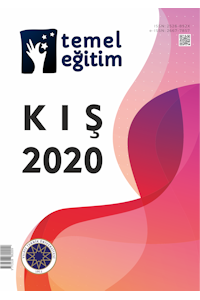Abstract
Araştırmanın amacı okuma güçlüğü yaşayan bir “evde eğitim öğrencisinin” okuma becerilerinin geliştirilmesidir. Bu amaçla önce öğrencinin mevcut okuma durumu belirlenmiş, daha sonra rehberli okuma yönteminin kullanıldığı 24 saat süren okuma çalışmaları yapılmıştır. Araştırmada nicel araştırma yöntemlerinden deneysel desenler içerisindeki tek denekli araştırma deseni kullanılmıştır. Araştırmanın verileri Akyol (2010) tarafından Haris ve Sipay (1990), Ekwall ve Shanker (1988)ve May’dan (1986) uyarlanan “Yanlış Analiz Envanteri”, yansıtıcı günlükler ve video kayıtları aracılığıyla toplanmıştır. Uygulama öncesi yapılan değerlendirme sonucuna göre öğrencinin okuma düzeyinin endişe düzeyinde olduğu belirlenmiştir. Ayrıca öğrencinin okuma sırasında ekleme yapma, atlayıp geçme, yanlış okuma ve tekrar ederek okuma gibi akıcılığa engel olan hatalar yaptığı, noktalama işaretlerine ve vurgulamalara dikkat etmediği belirlenmiştir. Uygulamanın ardından yapılan değerlendirmeye göre öğrencinin öğretim düzeyine ilerlediği, okuma sırasında yaptığı hataların azaldığı ve okuma hızının arttığı sonucuna ulaşılmıştır.
Thanks
Çalışmanın hazırlanmasında değerli katkılarından dolayı Doç. Dr. Nihan DEMİRKASIMOĞLU'na teşekkür ederiz.
References
- Aksoy, Y. (2013). Çocuk ve baloncu. [Çevrim-içi: http://www.butundunya.com/pdfs/2013/10/137-139.pdf], Erişim tarihi: 21.10.2019.
- Akyol, H. (2010). Türkçe ilk okuma yazma öğretimi. Ankara: Gündüz Eğitim.
- Akyol, H. (2019). Türkçe ilk okuma yazma öğretimi (17. Baskı). Ankara: Pegem Akademi.
- Amerikan Psikiyatri Birliği (1994); Mental bozuklukların tanısal ve istatistiksel el kitabı, (DSM-IV: Diagnosticand Statistical Manual of Mental Disorders) 4. Baskı, (çev. Ertuğrul Köroğlu), Hekimler Yayın Birliği, Ankara.
- Aşıkcan, M. (2019). Üçüncü sınıf öğrencilerinin akıcı okuma becerilerinin geliştirilmesine yönelik bir eylem araştırması. Yayımlanmamış Y. Lisans Tezi, Necmettin Erbakan Üniversitesi Eğitim Bilimleri Enstitüsü, Konya.
- Ateş, S. ve Yıldız, M. (2011). Okumayı farklı yöntemlerle öğrenen ilköğretim üçüncü sınıf öğrencilerinin sesli okuma akıcılıklarının karşılaştırılması. Türk Eğitim Bilimleri Dergisi, 9(1), 101-124.
- Baydık, B., Ergül, C. ve Kudret, Z. B. (2012). Reading fluency problems of students with reading difficulties and their teachers' instructional practices towards these problems. Elementary Education Online, 11(3).
- Büyüköztürk, Ş., Çakmak, E. K., Akgün, Ö. E., Karadeniz, Ş. ve Demirel, F. (2010). Bilimsel araştırma yöntemleri (5. Baskı). Ankara: Pegem Akademi.
- Deegan, C. E. L. (2010). A case study of the impact of guided reading groups in second grade on comprehension improvement. Doctoral Dissertation, Widener University.
- Duran, E. ve Sezgin, B. (2012). Rehberli okuma yönteminin akıcı okumaya etkisi. GEFAD / GUJGEF, 32(3), 633-655.
- Er, M. (2006). Çocuk, hastalık, anne-babalar ve kardeşler. Çocuk Sağlığı ve Hastalıkları Dergisi, 49, 155-168.
- Ergül, C. (2012). Okumada güçlük yaşayan öğrencilerin okuma performanslarının öğrenme güçlüğü riski açısından değerlendirilmesi. Kuram ve Uygulamada Eğitim Bilimleri, 12(3), 2033-2057.
- Güneş, F. (2007). Türkçe öğretimi ve zihinsel yapılandırma. Ankara: Nobel.
- Harris, A. J. ve Sipay, E. R. (1990). How to increase reading ability (9. Edition). Newyork: Longman.
- Higgins, L. G. (2009). An evaluation of the relationship between criterion-reference dcompetency test reading comprehension and lexile scores and fountas and pinnell’s guided reading levels in a Georgia public school district, Doctoral Dissertation, Liberty University.
- Johnson, A. P. (2017). Okuma ve yazma öğretimi (Çev. Ahmet Benzer). Ankara: Pegem Akademi.
- Karasu, H. P., Girgin, Ü. ve Uzuner, Y. (2013). Formel olmayan okuma envanteri. Ankara: Nobel Yayınları.
- Karasakaloğlu, N. ve Saraçlı Çelik, S. (2018). Rehberle okuma yönteminin ilkokul öğrencilerinin dinlediğini anlama düzeyleriyle akıcı okuma becerilerine etkisi. Electronic Turkish Studies, 13(19). 1083-1100.
- Kaya Tosun, D. (2018). Okuma çemberlerinin okuduğunu anlama, akıcı okuma, okuma motivasyonu ve sosyal beceriler üzerindeki etkisi ve okur tepkilerinin belirlenmesi, Doktora Tezi, Pamukkale Üniversitesi, Denizli.
- Koçer, D. (2018). Okuma bozukluğu. [Çevrim-içi: https://www.beyazokul.com/okuma-bozuklugu/], Erişim tarihi: 02.11.2019.
- Kodan, H. ve Akyol, H. (2018). Koro, tekrarlı ve yardımlı okuma yöntemlerinin zayıf okuyucuların okuma ve anlama becerileri üzerine etkisi. Eğitim ve Bilim, 43(193), 159-179.
- Mcginley, D.L. (2008). Effects of guided reading on motivation and comprehension in reading expository texts, Master’s Thesis, Caldwell College.
- Özdemir, O. (2013). İlköğretim öğrencilerinin öğrenme stillerine göre okuma güçlüklerinin giderilmesi, Yayımlanmamış Doktora Tezi, Gazi Üniversitesi Eğitim Bilimleri Enstitüsü, Ankara.
- Renne, M. (2010). The effectiveness of guide dreading on the reading achievement of a special needs 1st grade student, Master’sThesis, Caldwell College. Resmi Gazete (2018). Özel Eğitim Hizmetleri Yönetmeliği. Sayı, 30471.
- Rose, D.S.,Parks, M., Androes, K.,&McMahon, S. D. (2000). Imagery-based learning: improved elementary students reading comprehension with drama techniques. The Journal Of Educational Research. 94(1), 55-63.
- Sözen, N. ve Akyol, H. (2018). Rehberli okuma yöntemi: Bir eylem araştırması. Turkish Studies, 13(19), 1633-1658.
- Underwood, V. L. (2010). The effect of guided reading ınstruction on reading achievement, Doctoral Dissertation, Lindenwood University.
- Uzunkol, E. (2013). Akıcı okuma sürecinde karşılaşılan sorunların tespiti ve giderilmesine yönelik bir durum çalışması. Mersin Üniversitesi Eğitim Fakültesi Dergisi, 9(1), 70-83.
- Walizer, B. R. (2004). The impact of preservice teacher guided reading tutorials on the reading achievement and attitude of second graders, Doctoral Dissertation, Kansas State University.
- Williams, C. (2011). Small group reading practiceand oral reading fluency in second grade students, Doctoral Dissertation,Walden University.
- Yıldırım, A. ve Şimşek, H. (2013). Sosyal bilimlerde nitel araştırma yöntemleri. Ankara: Seçkin Yayıncılık.
- Yılmaz, M. (2008). Kelime tekrar tekniğinin akıcı okuma becerilerini geliştirmeye etkisi. Türk Eğitim Bilimleri Dergisi, 6(2), 323-350.
- Yurdakul, R.S. (2017). Azerbaycan'dan masallar-Azerbaycan folklorundan masal örnekleri. Ankara: MEB Yayınları.
Abstract
The aim of the research is to improve the reading skills of a home-schooled student who has reading difficulties. For this purpose, the current reading status of the student was first determined, and then reading studies that took 24 hours were conducted by using the guided reading method. In the research, a single-subject research pattern, which is one of the quantitative research methods, is used. The data of the study were collected through “False Analysis Inventory,” that was adapted from Haris and Sipay (1990), Ekwall and Shanker (1988) and May (1986), and reflective diaries and video recordings by Akyol (2010). According to the results of the evaluation made before the application, the reading level of the student was determined to be at the level of anxiety. Moreover, it was determined that the student made mistakes that prevent fluency such as adding, skipping, reading wrong, and repeatedly reading, and did not pay attention to punctuation marks or syllables. According to the evaluation made after the application, it was concluded that the student progressed at the level of education, his mistakes during reading decreased, and his speed of reading increased.
References
- Aksoy, Y. (2013). Çocuk ve baloncu. [Çevrim-içi: http://www.butundunya.com/pdfs/2013/10/137-139.pdf], Erişim tarihi: 21.10.2019.
- Akyol, H. (2010). Türkçe ilk okuma yazma öğretimi. Ankara: Gündüz Eğitim.
- Akyol, H. (2019). Türkçe ilk okuma yazma öğretimi (17. Baskı). Ankara: Pegem Akademi.
- Amerikan Psikiyatri Birliği (1994); Mental bozuklukların tanısal ve istatistiksel el kitabı, (DSM-IV: Diagnosticand Statistical Manual of Mental Disorders) 4. Baskı, (çev. Ertuğrul Köroğlu), Hekimler Yayın Birliği, Ankara.
- Aşıkcan, M. (2019). Üçüncü sınıf öğrencilerinin akıcı okuma becerilerinin geliştirilmesine yönelik bir eylem araştırması. Yayımlanmamış Y. Lisans Tezi, Necmettin Erbakan Üniversitesi Eğitim Bilimleri Enstitüsü, Konya.
- Ateş, S. ve Yıldız, M. (2011). Okumayı farklı yöntemlerle öğrenen ilköğretim üçüncü sınıf öğrencilerinin sesli okuma akıcılıklarının karşılaştırılması. Türk Eğitim Bilimleri Dergisi, 9(1), 101-124.
- Baydık, B., Ergül, C. ve Kudret, Z. B. (2012). Reading fluency problems of students with reading difficulties and their teachers' instructional practices towards these problems. Elementary Education Online, 11(3).
- Büyüköztürk, Ş., Çakmak, E. K., Akgün, Ö. E., Karadeniz, Ş. ve Demirel, F. (2010). Bilimsel araştırma yöntemleri (5. Baskı). Ankara: Pegem Akademi.
- Deegan, C. E. L. (2010). A case study of the impact of guided reading groups in second grade on comprehension improvement. Doctoral Dissertation, Widener University.
- Duran, E. ve Sezgin, B. (2012). Rehberli okuma yönteminin akıcı okumaya etkisi. GEFAD / GUJGEF, 32(3), 633-655.
- Er, M. (2006). Çocuk, hastalık, anne-babalar ve kardeşler. Çocuk Sağlığı ve Hastalıkları Dergisi, 49, 155-168.
- Ergül, C. (2012). Okumada güçlük yaşayan öğrencilerin okuma performanslarının öğrenme güçlüğü riski açısından değerlendirilmesi. Kuram ve Uygulamada Eğitim Bilimleri, 12(3), 2033-2057.
- Güneş, F. (2007). Türkçe öğretimi ve zihinsel yapılandırma. Ankara: Nobel.
- Harris, A. J. ve Sipay, E. R. (1990). How to increase reading ability (9. Edition). Newyork: Longman.
- Higgins, L. G. (2009). An evaluation of the relationship between criterion-reference dcompetency test reading comprehension and lexile scores and fountas and pinnell’s guided reading levels in a Georgia public school district, Doctoral Dissertation, Liberty University.
- Johnson, A. P. (2017). Okuma ve yazma öğretimi (Çev. Ahmet Benzer). Ankara: Pegem Akademi.
- Karasu, H. P., Girgin, Ü. ve Uzuner, Y. (2013). Formel olmayan okuma envanteri. Ankara: Nobel Yayınları.
- Karasakaloğlu, N. ve Saraçlı Çelik, S. (2018). Rehberle okuma yönteminin ilkokul öğrencilerinin dinlediğini anlama düzeyleriyle akıcı okuma becerilerine etkisi. Electronic Turkish Studies, 13(19). 1083-1100.
- Kaya Tosun, D. (2018). Okuma çemberlerinin okuduğunu anlama, akıcı okuma, okuma motivasyonu ve sosyal beceriler üzerindeki etkisi ve okur tepkilerinin belirlenmesi, Doktora Tezi, Pamukkale Üniversitesi, Denizli.
- Koçer, D. (2018). Okuma bozukluğu. [Çevrim-içi: https://www.beyazokul.com/okuma-bozuklugu/], Erişim tarihi: 02.11.2019.
- Kodan, H. ve Akyol, H. (2018). Koro, tekrarlı ve yardımlı okuma yöntemlerinin zayıf okuyucuların okuma ve anlama becerileri üzerine etkisi. Eğitim ve Bilim, 43(193), 159-179.
- Mcginley, D.L. (2008). Effects of guided reading on motivation and comprehension in reading expository texts, Master’s Thesis, Caldwell College.
- Özdemir, O. (2013). İlköğretim öğrencilerinin öğrenme stillerine göre okuma güçlüklerinin giderilmesi, Yayımlanmamış Doktora Tezi, Gazi Üniversitesi Eğitim Bilimleri Enstitüsü, Ankara.
- Renne, M. (2010). The effectiveness of guide dreading on the reading achievement of a special needs 1st grade student, Master’sThesis, Caldwell College. Resmi Gazete (2018). Özel Eğitim Hizmetleri Yönetmeliği. Sayı, 30471.
- Rose, D.S.,Parks, M., Androes, K.,&McMahon, S. D. (2000). Imagery-based learning: improved elementary students reading comprehension with drama techniques. The Journal Of Educational Research. 94(1), 55-63.
- Sözen, N. ve Akyol, H. (2018). Rehberli okuma yöntemi: Bir eylem araştırması. Turkish Studies, 13(19), 1633-1658.
- Underwood, V. L. (2010). The effect of guided reading ınstruction on reading achievement, Doctoral Dissertation, Lindenwood University.
- Uzunkol, E. (2013). Akıcı okuma sürecinde karşılaşılan sorunların tespiti ve giderilmesine yönelik bir durum çalışması. Mersin Üniversitesi Eğitim Fakültesi Dergisi, 9(1), 70-83.
- Walizer, B. R. (2004). The impact of preservice teacher guided reading tutorials on the reading achievement and attitude of second graders, Doctoral Dissertation, Kansas State University.
- Williams, C. (2011). Small group reading practiceand oral reading fluency in second grade students, Doctoral Dissertation,Walden University.
- Yıldırım, A. ve Şimşek, H. (2013). Sosyal bilimlerde nitel araştırma yöntemleri. Ankara: Seçkin Yayıncılık.
- Yılmaz, M. (2008). Kelime tekrar tekniğinin akıcı okuma becerilerini geliştirmeye etkisi. Türk Eğitim Bilimleri Dergisi, 6(2), 323-350.
- Yurdakul, R.S. (2017). Azerbaycan'dan masallar-Azerbaycan folklorundan masal örnekleri. Ankara: MEB Yayınları.
Details
| Primary Language | Turkish |
|---|---|
| Subjects | Studies on Education |
| Journal Section | Araştırma Makaleleri |
| Authors | |
| Publication Date | January 15, 2020 |
| Submission Date | May 16, 2020 |
| Published in Issue | Year 2020 Volume: 2 Issue: 1 |




 No APCs or Submission Charges
No APCs or Submission Charges